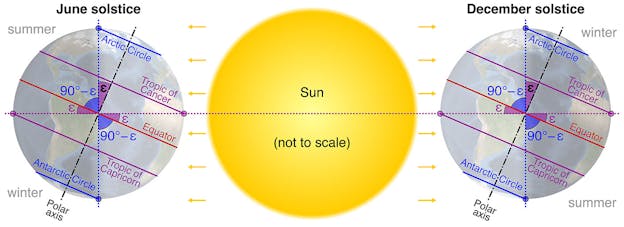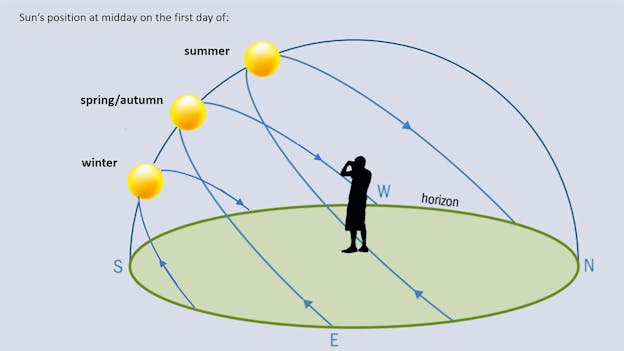Watches And Wonders 2025: A Guide To Understanding The Vacheron Constantin Solaria Grand Complication, Part I
Vacheron debuts the most complicated wristwatch ever made – here’s an in-depth look at its amazing complexity, and at the astronomy behind some of its more perplexing indications.
This year’s Watches & Wonders was interesting for two developments which are pretty difficult to digest. The first of these is the new Rolex Dynapulse escapement, whose action is most subtle and ingenious, and also enough unlike anything else which has preceded it, to be even more counterintuitive to understand than escapements are in general. The second is the subject of this story: a supercomplication from Vacheron Constantin which is the most complicated wristwatch ever made, and which seems to require among other things, a degree in astronomy to understand. It has always been my belief, though, that such things are meant to be understood if we can, not merely admired for their incomprehensible complexity, so I felt obliged to take a shot at really explaining just what the complications – especially the astronomical complications – in the Solaria are really all about.
The world’s most complicated watch has a simple name – Solaria – but the watch is dauntingly complex at first glance (and at second and third glance too, for that matter). There are certainly parts of it that will be more or less familiar to most watch enthusiasts – clearly, there’s a perpetual calendar; clearly, there’s a planispheric star chart on the back; the moonphase and GMT indications aren’t hard to spot and the sunrise/sunset indications are straightforward (or they seem to be; they’re a little more complicated than at first glance).

To understand what we’re looking at, it’s first of all essential to note the time and date, as well as the location, shown on the watch. In the pics provided by Vacheron, the watch is set to 10:09 AM, and the date is August 29, 2025. The solar indications are dependent on latitude and the watch is set up to show correct solar indications throughout the year in Geneva. Also, bear in mind that all solar indications are shown in Standard, not Summer, time, despite the fact that the watch is set for a date in August, when CET Summer Time is in effect. Now we can look at the complications.
The Solar Indications
The Solaria has two faces – the front of the watch is devoted to solar complications, and the back of the watch, to stellar indications; in simpler terms the front is devoted to the day and the back, to the night.
On the front of the watch, there are four subdials, and peripheral indications just inside the bezel. At 12:00, we have the perpetual calendar and week indicator. At 3:00, there’s a second time zone display with day/night indication and reference city.
At 6:00, there is the most complex of the four subdials _ this display shows (and we’ll get into what all this means in just a minute) the Equation of Time, time of true local solar culmination, declination of the Sun as it changes throughout the year due to the tilt of the Earth’s axis, and the current sign of the Zodiac, as well as the solstices and equinoxes. The display also shows the height above the horizon of the Sun in degrees, throughout the year – the Sun is at its lowest in the sky at its culmination during the Winter Solstice, when it only rises 20.36º above the horizon at noon; it is at its highest in the sky at its culmination on the Summer Solstice, when it reaches 67.19º above the horizon. The Sun at its culmination on the Equinoxes reaches 46º above the horizon and the maximum at the Summer Solstice, minimum at the Winter Solstice, and middle of the range at the Equinoxes, are all shown on the sector for the height above the horizon.
On the periphery of the dial, there is a narrow sector from about 8:30 to 4:30; this shows the times of sunrise and sunset, as well as duration of daylight hours, and the position of the Sun in the sky.

Finally, the subdial at 9:00 shows the phase of the Moon (to a precision of one days’ error in 122 years) as well as a tide indication. Let’s look in more detail at some of the more complex – and less intuitively understandable – indications at 6:00 and 9:00.
The Tide Indicator
The tide indicator – also shows high and low tides, but it also shows when Spring and Neap tides occur. This indication, as well as the numerous solar indications in the subdial at 6:00, has some interesting and easy-to-miss details.

The high and low tides are shown by the curve between the black (high) and white (low) sections on the tide indicator disk. There are two low tides and two high tides every lunar day – not every solar day; the lunar day is slightly longer at 24 hours and 50 minutes. The gravitational attraction of the Moon produces a tidal bulge and twice a day, a given point on the Earth’s surface will pass through the bulge, producing a high tide. The black/white curve therefore rotates once every 24 hours and fifty minutes to show the tides. The Solaria shown at Geneva has Geneva as its location, and although Lac Leman (Lake Geneva) is quite deep, it doesn’t have true lunar tides, but the tide indicator does show what they’d be if Geneva was by the seaside (instead of in the middle of one of the most landlocked countries in Europe).
The tide indicator also shows when in the tidal cycle Geneva (if it had tides) would experience what are called Spring tides and Neap tides. Spring tides are tides in which the difference between low and high tide, or the tidal range, is the greatest; Neap tides are when the difference is the least. Spring tides happen when the Earth, Moon and Sun are aligned (the Moon can be either in front of the Earth or behind it to create Spring tides; this alignment is called syzygy, if you’re looking for a new Scrabble word) and Neap tides occur when the Moon is at right angles to the line between the Earth and the Sun; the former has an additive effect on the gravitational tidal forces while the latter produces a weakening of the overall gravitational forces. Spring and Neap tides occur, therefore twice each per lunar month.

In the tide indicator for the Solaria, the increase and decrease in gravitational forces that produces these tidal variations is show by the green sine wave. You can’t quite see it clearly in the presskit images but the green wave is on a different disk which rotates once per lunar month above the tide indication. On August 29 2025, the Moon is going to be about a week past its third quarter – not close enough to a waning crescent to produce a true neap tide, but close enough to produce a fairly small tidal range.
The Sunrise, Sunset, And Duration Of Daylight Indication
As mentioned this indication is shown in a sector on the outside of the dial. The times of sunrise and sunset are shown by the two yellow arrows, indicating those times on a 24 hour clock, while the duration of the day, or number of daylight hours, is show by the red arrow. The intervals between hours are marked off in fifteen minute increments.
The position of the Sun in the sky is shown by a small yellow circle which rises on the left and sets on the right. Sunrise and sunset have several phases – there are defined times for instance, for three different types of dawn and twilight (civil, nautical, and astronomical) but sunrise and sunset are defined by the moment when the upper or lower edge of an idealized Sun touch an idealized horizon.

As you can see above, you can also (as Vacheron mentions in its press material) see the position of the Sun in the sky; you can do that more or less directly if you orient the watch so 12:00 is facing the South (in the Northern hemisphere, where Geneva is located, the arc of the Sun follows a path across the Southern sky).
Sunrise is shown as taking place at 5:53, and sunset, at 19:17 (7:17 PM) with a little over 13 hours and 15 minutes of daylight.
If you look up the times of sunrise and sunset in Geneva for August 29, 2025, you might see 6:53 and 8:17 – an hour ahead of the times shown on the indication. That’s because the source for the times may be showing the times in Central European Summer Time, which is an hour ahead of CET standard time; hence the discrepancy. As we mentioned, the sunrise/sunset/duration indication uses standard rather than Summer time. This chart shows the times in standard time through all of 2025.
The Equation Of Time, Solar Culmination, Solar Height, Equinox/Solstice/Seasons, And Zodiac Indication
The subdial at 6:00 is chock full of astronomical indications and shows the physical relationship between the Earth and the Sun throughout the year. To understand what we’re looking at, let’s first take a quick look at how the path of the Sun across the sky looks from the Earth.
The Sun is famously and rightly considered dangerous to look at directly and especially for us urbanites, the basics of its path across the sky may come as something of a surprise. The Sun, despite appearances, is never directly overhead at many locations on Earth, including Geneva. This is thanks to the axial tilt of the Earth – the Earth’s axis is inclined (tilted) by about 23.44º from the Plane of the Ecliptic, which is the imaginary plane in which the Earth and other planets orbit the Sun, as if we were all rolling along on the same invisible plate.
As the Earth orbits the Sun, the inclination of the axis remains constant so that from the Earth, the highest point of the Sun’s apparent path across the sky seems to rise and fall over the course of the year.

The solstices, as seen above, are the days on which the Sun is highest or lowest in the sky. As you can see, the Sun is never directly overhead at any time of the year, except in the latitudes between the Tropic of Cancer and the Tropic of Capricorn. Geneva is quite a bit further north than the Tropic of Cancer, which is at 23.5º North vs. 46.21º North for Geneva – so in Geneva, even on the Summer Solstice, the Sun isn’t directly overhead. As seen from Geneva (and any other location in the Northern Hemisphere) the Sun appears to follow a curved path across the southern sky.

The moment at which the Sun reaches its highest point on any given day, is called its culmination, this is also the moment at which the Sun crosses your local meridian, which is the longitude line of your location projected onto the sky; this line runs directly North and South across the sky, just as a line of longitude runs from South to North on the Earth’s surface.
The declination of the Sun on any given day, is the angle of the Sun above or below the celestial equator – this is the plane of the Earth’s equator, projected onto the celestial sphere.
The last important thing to understand in order to understand that subdial at 6:00, is the Equation of Time. As fans of astronomical complications will remember, a 24 hour day is actually a mean, or average, solar day – over the course of a year, thanks partly to the tilt of the Earth’s axis, and partly to the fact that its orbit is an ellipse, rather than a perfect circle, an actual solar day on any given day may be longer or shorter than a mean solar day. The difference between the mean and actual solar day is called the Equation of Time. A sundial always shows true solar time, so you can think of the Equation of Time as the difference between the time shown on a sundial, and the time shown on a clock (and in the old days, in fact, clocks often had a table of the Equation of Time pasted inside the case, to help the owner set the mean time from a sundial).
Now let’s look at the indications.

The position of the Sun in the Zodiac is shown in an aperture in the lower quarter of the subdial; it’s August so all you astrology mavens out there will not be surprised to see that the Sun is in Leo. The aperture also shows that it’s summer (naturally) and that the fall Equinox (in green, “EQ”) is coming up.
Next, you can see the Equation of Time for August 29, 2025, on the sector marked ±15 minutes in the upper part of the subdial. On that date, the Equation of Time is shown to be about +1 minute.
The time of solar culmination – the moment when the Sun reaches its highest point in the sky – is shown by a golden hand on a sector, marked 12:35 more or less in the middle, and running from 20 to 50 as you go around the sector clockwise. Here’s a clue to what’s going on – 12:35 + 15 minutes is 12:50, and 12:35 – 15 minutes is 12:20 – and you’ll remember, the range of the Equation of Time is very roughly fifteen minutes plus or minus mean solar time. 12:35 is the time of solar culmination in Geneva on days when the Equation of Time is zero, which happens four times per year. On any given day, the time of solar culmination will be that time, plus or minus the Equation of Time for that day; and as you can see, the Equation for this date is +1 – and lo and behold, the time of solar culmination is 12:35 + 1 as well; 12:36. This is by the way, a highly unusual astronomical indication – although there are many watches which show the Equation of Time, the only other wristwatch I know of with this capability is the long discontinued Jules Audemars Equation Of Time, from Audemars Piguet.
The Height of the Sun above the horizon on any given date is shown in a sector on the upper right. As you can see there’s quite a bit of variation – a maximum of 68º on the Summer Solstice (June 21, in Geneva on 2025) and a minimum of 20º on the Winter Solstice (December 21) – well, that’s why winter’s so cold and summer’s so hot.
The little gold sphere represents, fairly obviously, the Sun, and in the image, the Earth is rotating counterclockwise – towards a negative solar declination, and also carrying the Northern hemisphere further and further away from direct sunlight.
And that’s all in just one subdial of the Solaria – you start to really appreciate just how complex the watch is overall when you realize that just that one subdial at 6:00 holds more complications than you find in most other watches entirely (including one – solar culmination – which is almost unique, and which in its design is completely unique to the Solaria.
Now let’s take a breather, and then take a look at the back, where the stars come out to play.
The Vacheron Constantin Les Cabinotiers Solaria Ultra Grand Complication ref. 9600C/000G-231C: Case, 45mm x 14.99mm, 18k white gold, sapphire crystals front and back. Movement, Vacheron Constantin caliber 3655, 36mm x 10.96mm, with 72 hour power reserve. Complications include perpetual calendar, 14 astronomical and 3 lunar indications, split seconds chronograph with isolator; peripheral power reserve indicator (on the back) and minute repeater with Westminster carillon chimes. Unique piece; price available upon request (Vacheron will produce the Solaria on request as part of the Les Cabinotiers collection, although it’s a piece unique in the configuration shown). Movement with Geneva Seal, and of course, it’s the most complicated wristwatch ever made.
Part 2: Stellar Complications, Chiming Complications, And The Rattrapante Chronograph

